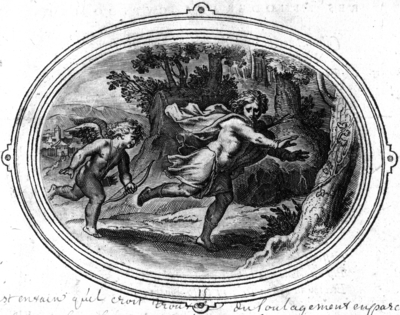Ille fuga silvas saltusque peragrat [15]

Translations
 |
Vergilius, Aeneis 4, 72 and 73
Vluchtend doorkruist de hinde Dicte's ravijnen en bossen. Tevergeefs want in haar zijde hangt het doodbrengend riet. [Vert.
M.A. Schwartz, Haarlem 1969, p. 59] |
 |
Vergilius, Aeneis 4, 72 and 73
The hind in flight ranges the Dictaean woods and glades, in vain, for fast to her side clings the deadly shaft. [cf. tr. H.
Rushton Flairclough, Loeb, p. 401] |
Literature
- Henkel and Schöne, Emblemata
 , col. 962
, col. 962
- Praz, Seventeenth-Century Imagery
 , pp. 103-104
, pp. 103-104
- Sebastiàn, Lectura crítica
 , p. 20
, p. 20
Sources and parallels
- Ille fuga silvas saltusque peragrat [12] (in: Otto Vaenius, Emblemata aliquot selectiora amatoria (1618))
[Compare
![Compare [compare]](/static/images/compare2.gif) ]
]
- Same quotation (Propertius) used by Cats to express the same sentiment ('wat int herte woont dat voert men over al'): Fugiendo, non effugit. [15] (in: Jacob Cats, Sinne- en minnebeelden (1627))
[Compare
![Compare [compare]](/static/images/compare2.gif) ]
]
- Praz compares: Et piu dolsi [15] (in: Daniël Heinsius, Emblemata amatoria (1607/8))
[Compare
![Compare [compare]](/static/images/compare2.gif) ]
]
-
Praz compares: Et piu dolsi [15] (in: Daniël Heinsius, Quaeris quid sit Amor (c. 1601))
[Compare
![Compare [compare]](/static/images/compare2.gif) ]
]
- Sebastián compares this to: Junius, Emblemata [web]
 , embl. 47
, embl. 47
-
But perhaps there is more resemblance to: Mon mal me suit [22] (in: Daniël Heinsius, Quaeris quid sit Amor (c. 1601))
[Compare
![Compare [compare]](/static/images/compare2.gif) ]
]
-
But perhaps there is more resemblance to: Mon mal me suit [22] (in: Daniël Heinsius, Emblemata amatoria (1607/8))
[Compare
![Compare [compare]](/static/images/compare2.gif) ]
]
References, across this site, to this page:
- Fugiendo, non effugit. [15] (in: Jacob Cats, Sinne- en minnebeelden (1627))
- Et piu dolsi [15] (in: Daniël Heinsius, Quaeris quid sit Amor (c. 1601))
- Mon mal me suit [22] (in: Daniël Heinsius, Quaeris quid sit Amor (c. 1601))
- Et piu dolsi [15] (in: Daniël Heinsius, Emblemata amatoria (1607/8))
- Ille fuga silvas saltusque peragrat [12] (in: Otto Vaenius, Emblemata aliquot selectiora amatoria (1618))
Iconclass
A man is fleeing too late from a cupid: he is already hit by an arrow- forest, wood
[25H15]

- landscape with tower or castle
[25I5]

- running
[31A27112]

- violent death by arrow(s) - EE - death not certain; wounded person
[31EE23461]

- flight, running away; pursuing
[33B9]

- man in flight (one-sided courting)
[33C314]

- archer's weapons: arrow
[45C15(ARROW)]

- archer's weapons: bow
[45C15(BOW)]

- quiver
[45C23]

- Authority, Power; 'Dominio', 'Giurisdittione' (Ripa) (+ emblematical representation of concept)
[53C11(+4)]

- (personifications and symbolic representations of) Love; 'Amore (secondo Seneca)' (Ripa) (+ emblematical representation of
concept)
[56F2(+4)]

- proverbs, sayings, etc. (with TEXT)
[86(ILLE FUGA SILVAS SALTUSQUE PERAGRAT)]

- Cupid struggling with or tormenting other persons, abstract concepts, (fabulous) animals, etc.
[92D142]

- 'Omnia vincit Amor', Love the conqueror, Love triumphant
[92D1511]

- Cupid handling his weapons
[92D152]

- attributes of Cupid (with NAME)
[92D18(ARROW)]

- attributes of Cupid (with NAME)
[92D18(BOW)]

- attributes of Cupid (with NAME)
[92D18(QUIVER)]

![[H O M E : Emblem Project Utrecht]](/static/images/rd-small.gif)


















































































































































